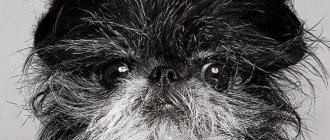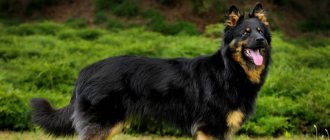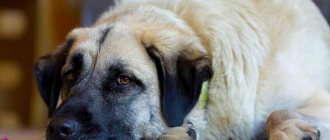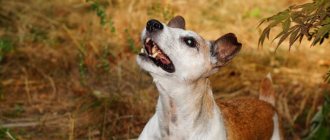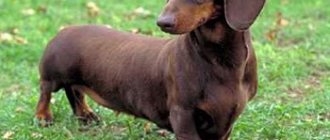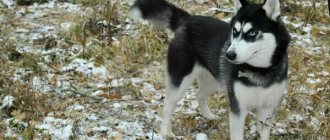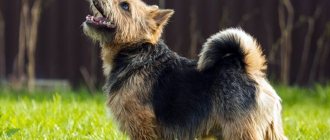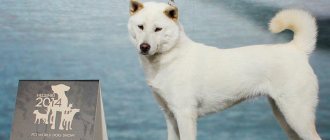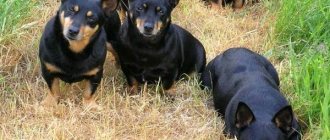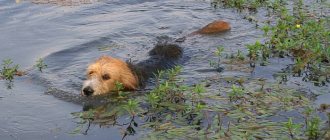History of the origin of the breed
Norwich dogs were developed in the mid-19th century. The homeland of dogs is the city of Norfolk, and the man who contributed to the appearance of such charming dogs was a hunter seeking to breed a breed capable of hunting and accompanying its owner in unusual conditions in the East of England.
The English county of Norfolk has long been famous for its forests rich in game. The best of each breed of dog was brought to the county from all over Foggy Albion. Therefore, it is not surprising that it was there that a whole “galaxy” of hunting terriers appeared, including the Norwich Terrier, an excellent catcher of small game like rabbits and badgers, who, in addition to his immediate duties, also guarded the owners’ barns from rats.
It is most likely that representatives of the breed were formed by the middle of the 19th century, but it was registered only in 1932. For a long time, two varieties existed in parallel in the breed - with hanging and erect ears, but soon it was decided to separate them. This is how a new breed appeared, named after the county - the Norfolk Terrier, whose peculiarity is the drooping corners of the ears.
For a long time, breeders could not decide on a name for the second variety of the breed, since in different places these dogs were called differently. So, in their homeland, in the city of Norwich, they were called “rethunters” - rat hunters or “regs” - shaggy ones. This name was obtained due to the tousled fur, especially on the face.
The terrier was especially loved among Cambridge students, who considered it their mascot and wanted to give the breed the name of the university. Nevertheless, it was decided to give the breed a name in honor of its hometown and the capital of the county - Norwich.
The Norwich has a visual resemblance to the Yorkshire Terrier, but there is an explanation for this. The ancestor of the Norwich is the black and tan English terrier, which was bred by breeders by crossing a Yorkie and an Irish terrier.
History of the breed
The Norwich Terrier is the result of crossing three breeds. Mobile creatures were born at the end of the 19th century in eastern England.
The Norwich Terrier has a twin brother - the Norfolk Terrier . The only difference between them is in the ears; Norwich's have erect ears, while Norfolk's have drooping ones.
They are also very similar in character.
There was a time when this breed was called the Cambridge Terrier. She was the symbol of the educational institution.
And the reason is very simple - these little miracles have become popular among students. This happened approximately 10 years after the breed was developed.
The tousled fur of animals gave them another name - shaggy, that is, “rags”.
Although the breed was bred in England, it gained one of its greatest popularity in America. In this country the breed was called the Jones Terrier.
Owners often complain that Norwich Terrier dogs become uncontrollable when left off leash outside. The hunt for other dogs and birds begins. This is a disadvantage that can be eliminated by training the animal. But it is impossible to completely eradicate the hunter instinct
Description of the breed
According to general ideas about the breed, one can see the features of a typical hunting dog - a small dog with a strong bone skeleton and a moderately wide chest. The type is squat, the body is as massive as possible, which contributes to endurance. By temperament, dogs have a little unpredictability.
According to the standard, Norwich dogs have a distinct characteristic - they do not fool around, but with increased activity, endurance, determination and tirelessness. This breed is one of the smallest representatives of its class, as evidenced by their weight, not exceeding 5.3 kg, and height of 27 cm.
The head is only visually large due to the large accumulation of hair on the muzzle. The shape of the skull is typical for the terrier class: a spacious cranium, rounded towards the top, the frontal part is flat, sharply transitions to the nose, where the muzzle narrows. The muzzle is a third shorter than the skull, but this does not weaken it. The lip is pigmented, thin, and fits tightly to the second.
The teeth are large and appear less proportional when looking at their overall appearance. The incisors are of ideal even shape, the fangs are tightly compressed. A dog with the correct bite, no gaps.
The nose is one of the most sensitive parts of the body. It is black in color, but may have flesh spots and is mobile.
The eyes are of medium width, slightly recessed into the orbital area, which serves as protection for the dog. Eyes with an oval cut, brown color. The eyelids fit tightly to each other. Thanks to its expressive look, the dog seems like an eternal puppy who is interested in everything.
The ears are medium, stand up all the time, have the shape of a triangle, but due to the large amount of hair it seems that the ears are too small. When the dog is concentrated, the ears are tense and move slightly forward; when the animal is calm, they move back.
Strong rectangular body . The neck is short due to its thickness, but this guarantees stability. The scruff or dewlap is not pronounced. The chest is of medium width so as not to interfere with movement. Springy ribs with a noticeable stretch back. The shoulder part is well developed with a sloping croup.
The front legs have less pronounced muscles. The limbs are short, but smooth and thick. Shoulders pulled back, elbows toward sternum with wrists toward the ground. The thighs are of moderate length, but they are quite strong. The stifle and metatarsal joints are at a natural angle, which makes the dog more powerful. The paw pads are strong, as the dog is an excellent digger and also runs quickly.
The tail is short, but thick, adjacent to the dorsal line. It can be natural or cropped. The tail itself is naturally powerful, without rounding, but slight irregularities are acceptable. After docking, it has a straight type that continues the dorsal line.
What should a Norwich Terrier look like according to the standard?
The Norwich Terrier is a small, compact dog with strong bones and short legs. This is one of the smallest terriers - height at withers 26 cm, weight 5-6 kg.
The skull is round, wide, and the stop is well defined. The muzzle is strong, wedge-shaped, the length is approximately one third less than the length of the head. The lips fit tightly, the jaws are powerful, even, with massive teeth and a regular scissor bite. The eyes are oval-shaped, small, expressive, dark in color. The ears are not set very wide, erect, the auricle is of medium size with pointed tips. In an alert state they are raised, and in a relaxed state they can be laid back. The neck is long, powerful, and flows smoothly to the shoulders. The back is compact, the topline is level. The loin is short. The chest is long and the ribs are well sprung, giving it good depth. The tail can be docked and set high, ideally complementing the topline.
The undocked tail is of medium length, wide at the base and gradually tapering to the tip. Should be as straight as possible and carried high, complementing the topline. The elbows are pressed tightly to the body, the paws are short and straight. The hind legs are wide, muscular, the knee joints are well defined, the paws are round, short, and point backward when moving.
The coat is double, consisting of a hard, wiry, straight coat that does not fit tightly to the body, and a thick undercoat. The hair on the neck is longer, stiffer, and forms a collar that frames the muzzle. The hair on the head and ears is shorter and smoother, with the exception of small eyebrows and whiskers. Several colors are recognized: all shades of red, wheaten, black and tan and grizzly with gray hair. White markings and spots are undesirable.
Colors
The Norwich Terrier has the classic color for terriers. The structure of the fur is hard, wiry, bristling in all directions. The guard hairs lengthen toward the neck area, giving the appearance of a collar. The hair on the face is shorter. Located and clearly visible on the chin and eyebrow area. The undercoat is obligatory and developed.
The following colors are allowed:
- red – bright red, fawn;
- black and red color;
- pinky – creamy red, with a pinkish tint;
- wheat;
- black – the color on the back is darker than on the whole body, reminiscent of a saddle;
- grizzly - an equal combination of red and black;
- tan – black with tan markings on the face, paws, and chest.
The main feature is the absence of white color. No inclusions of this color are allowed by the standard.
Breed description, standards and appearance
The description of the breed is included in the Norwich standard in the official FCI list. According to it, judges and breeders determine the correctness of the individual’s external data.
The norm for Norwich Terriers is 5-6 kg with a height at the withers of 24-26 cm.
Characteristics speak of terriers as dogs with a slightly careless appearance. In fact, Norwich dogs are distinguished by their gracefulness and sleek, graceful body:
Color and coat type
Norwich Terriers have long, coarse hair that sticks out in all directions. Without regular grooming, the hair of dogs of this breed grows excessively and turns into dreadlocks. The shortest cover is on the face and ears.
The standard description of Norwich dogs allows the following colors:
Terriers may have gray spots on the ears and paws, and strands of shades that are not the main color.
Character and behavioral characteristics
Norwiches are smart and proud dogs who love their owners passionately. Excellent companions, they are friendly and active. They differ from many breeds in their calm attitude towards loneliness - they do not whine or “cry” in the absence of people, and do not damage furniture and shoes. They are easy to train and love agility and other dog activities.
A hunting dog has the habits and habits of the breed. Norwich are susceptible to the influence of natural instincts, which is manifested in the following features:
- They cannot walk without a leash. One of those breeds that requires special training, since their tendency to search and pursue prey does not allow them to be allowed to go for independent walks;
- Dangerous neighbors. Representatives of this breed, in principle, do not get along well with other pets: Norwich dogs are aggressive towards rodents and cats, as they were bred specifically for hunting animals of this size;
- Impatient with children's aggression. Many owners talk about how their pets steadfastly endure the mischief of children who pull their dogs’ noses and tails. The terrier cannot be called a fan of such games, and he can fight back. The child must immediately be explained that the terrier is not a toy.
Education and training
Training is practically no different from that which is carried out with other representatives of terriers. Some breeders are practically unable to cope with the character of the Norwich, so they resort to the help of dog handlers. Difficulties begin at the first stage of basic training. Carried away by the area, the Norwich Terrier may ignore the owner’s commands, as he is often lost or completely lacks attention.
Even in old age, activity and endurance are maintained, the dog remains energetic, with increased mobility. To keep fit, it is recommended to exercise your dog regularly.
- The recommended duration of training is no more than an hour, regularity is once every two to three days.
- The Norwich Terrier loves to play. Therefore, for a walk you need to take a tug-of-war rope and other toys of this type. There is no effect from the dog playing in the apartment. Therefore, the owner must provide the pet with activity.
- There is no need to be surprised that during the game the dog can play too much and become aggressive. They love to remain the winner in any competition.
- Physical punishment is the worst way to get what you need to know.
- If the dog needs to be punished for bad behavior, the owner must use the tactic of ignoring - immediately after the offense, reprimand the animal in a stern voice and not notice it for several hours.
- The best method is encouragement.
Each animal is individual. Dogs have different personalities, and how you train an animal at the age of a puppy is how it will behave in the future.
Terriers are not dogs for street keeping; cold and constant loneliness will have a bad effect on health and behavior. The terrier can be kept both in the house and in the apartment, since it does not shed, its coat is odorless, it tends to be clean, it is calm, and with proper training it never damages furniture. Unlike many small breeds, the Norwich Terrier is not capricious and does not require constant attention.
Pros and cons of the breed
Happy owners of the Norwich Terrier breed will never say anything bad about their pets. And there’s nothing to it – animals are cheerful, active, loving and devoted. But such excessive energy is not suitable for everyone.
People accustomed to a calm, phlegmatic life will find more disadvantages than advantages in Norwich.
ProsCons
| Good health | Rare breed, difficult to find in Russia |
| Activity, mobility, perky character | Difficult coat care |
| Unpretentiousness in care and maintenance | Special nutrition is required, high-quality feed costs a lot of money |
| Developed intelligence, understanding | Without education, can become aggressive |
| Good adaptability to changing living conditions | Restlessness, constant need for walking and training |
| Agreeableness | Love of garbage, dirt, digging, swimming in puddles |
Despite the fact that literally everyone adores Norwich Terriers for their cute fox faces, they are one of the rarest breeds. In Russia there are still few nurseries engaged in its breeding. Hence the rather high price for puppies. But I hope that over time the number of Norwich dogs at dog parks will increase.
Diseases
The breed was bred for hunting, so the Norwich Terrier at puppy age is quite hardy and rarely susceptible to disease. But the most common diseases in these dogs are:
- epileptic syndromes;
- tracheal collapse;
- brachycephalic disease (soft palate lengthens);
- allergy to certain cereals.
- pancreatitis;
A dog may have rabies, plague, or infectious hepatitis. But only timely vaccination can save you from this.
The average life expectancy of terriers is twelve to sixteen years.
Terrier puppies are born with large heads, so females need veterinary care.
Many terriers have problems with the spine; the best prevention is proper nutrition and exercise.
Care
Norwich Terrier dogs do not require complex care. The coat is combed once a week. Like many wire-haired breeds, they do not shed seasonally, that is, old dead hairs do not fall off, but remain in place in the form of a dense “shell.”
Haircut, trimming and bathing
Grooming, trimming or plucking dead hairs on your dog will help keep the coat clean and well-groomed. Thanks to this procedure, the room is cleared of animal hair. Trimming prevents blocking of skin pores, which occurs when new hair grows, but existing hair that has died is in the way. With careful plucking, the quality of the animal's fur is preserved.
The procedure must be carried out at least a couple of times a year; for this, you can contact professional groomers or carry out the procedure yourself. This requires special knowledge, since inexperienced work can ruin the appearance of the animal.
Theoretically, there is nothing complicated, but you need to understand which hairs should be plucked. Therefore, it is recommended to carry out the first procedure of plucking dog hair with a knowledgeable person. This will get rid of troubles for the dog.
Due to its size, the Norwich Terrier does not get very dirty at home, and its coat does not get tangled, which allows it to be washed whenever it gets dirty.
Bathing should not be done frequently; it is advisable to wash it whenever it gets dirty. Dogs need weekly eye and ear examinations and cleanings.
It is unacceptable to use shampoos not intended for dogs. This can negatively affect the quality of the wool.
After walks, it is necessary to check for ticks, and also periodically treat the animal for helminths.
Description of the character of the Norwich Terrier breed
Norwich Terriers took only the best qualities from their relatives. They do not have the nervousness, mistrust, stubbornness and mood swings inherent in other terriers. These sweet, good-natured dogs are very playful, active and noisy. To avoid bitten clothes and shoes, it will be good to get a ball and other toys.
They treat their owners with tenderness and devotion, expecting love and affection from them in return. Norwich are good with children and enjoy frolicking with them. But in their relationships with pets, not everything goes smoothly. Various cats, guinea pigs and hamsters are primarily hunted for them.
An exception may be animals that were already in the house at the time of their arrival. For the same reason , you should only walk Norwich dogs on a leash, so that they do not chase a cat or small dog, dooming themselves to danger.
Norwiches do not require special care and can rightfully be considered city dogs. But in a private house, they will certainly feel much more comfortable for the reason that there they can freely run around the yard, and not wait for the owners to deign to take them out for a walk.
But do not forget that this is a hunting dog that is used to tearing holes. Therefore, you may have to say goodbye to some of the flower beds or beds.
Feeding
The Norwich Terrier loves to eat a lot, so no matter how much he puts on his plate, he will eat it all. Owners should control portions for their pet.
The diet is selected to be balanced with all the main components: proteins, fats, carbohydrates. The obligatory presence of buckwheat, rice, fermented milk products, dietary meat, eggs, cottage cheese, cereals, vegetables and some fruits.
You can add vitamin supplements as complementary foods, which your veterinarian will recommend. It is strictly contraindicated to feed chocolate, bird bones, fatty meats, and spices.
Among artificial foods, the most suitable for Norwich are specialized mixtures for small wire-haired breeds of the highest quality. Low-quality ones lead to diseases of the gastrointestinal tract, problems with teeth and gums, and hair loss.
At a young age, ingredients rich in vitamins should be supplied. If there is a lack of any microelements, the development and growth of the baby is suspended. Upon arrival to the new owner, it is recommended to give soaked dry food, so it is gradually transferred to natural food. If you immediately feed natural food, the puppy will suffer from an upset stomach.
It is advisable to feed before the family sits down to the table, so that a well-fed animal does not beg for handouts from the table.
How to choose a puppy
What shape the tail has, whether the ears are erect, whether the body is proportional - this is what the owner should pay attention to when choosing a puppy of this breed in the kennel. This is especially true for show animals.
Before assessing the baby, attention is paid to the mother and father, or one of them.
By all standards, the puppy should already be accepted, right down to the coat color. A roundish skull that widens towards the ears. A clear boundary of the transition from the forehead to the nose. The muzzle appears short when compared to the skull. A child with a scissor bite – the upper row of teeth overlaps the lower one. The teeth are almost perfectly straight, but do not protrude, being perpendicular to the jaw. The ears are always erect and have a clear triangle shape. Due to the fact that the neck is thick, it appears short.
The tail is straight; if the dog goes to a show, it is not docked. The limb thickens towards the base, tapering at the end. The paws are similar to those of a cat, but shorter and thicker.
If the paws are tilted at any angle, this indicates that the breed is damaged.
The hairs of the coat are hard and have a thick undercoat. The fur in the neck area is lengthened, giving the appearance of a muff. The baby can have the following colors: fawn, black and tan (black and tan), zone, as well as any of the shades of orange. If there are white inclusions, this indicates a deviation from the FCI standard. Looks like its parents at 3-4 months.
Norwich Terrier puppies
A person who has decided to buy himself a little mischievous four-legged friend must approach this matter responsibly, especially if the dog is also needed for exhibitions. When choosing, it is important to pay attention to the position of the ears, proportions, and the bend of the tail. Before moving on to examining the baby, it is worth looking at at least one of the parents - he must meet the breed standards. The puppy already at 3-4 months becomes similar to its parents. It's a bad sign if the dog's limbs move apart.
Where can I buy
The Norwich Terrier is one of the friendliest and most capable dogs that will become your faithful friend and favorite of every family member. It is recommended to purchase a representative of this class of small dogs from specialized nurseries - this way you will be confident in the breed, the availability of the necessary documents for the animal, and timely vaccination. A purebred puppy that meets the standards can be bought in Moscow and St. Petersburg:
- Solven House nursery (Moscow, breeder – Svetlana Avdeeva, tel.: +79160106575);
- multi-breed nursery Solar Sofi (Moscow region, Domodedovo, tel.: +79645110452);
- dog kennel “Nevsky Paradise” (St. Petersburg, tel.: +79219036125).
How much are
In Moscow, puppies are bought secondhand through advertisements on the Internet, at the poultry market and in specialized nurseries, while the price of a dog varies markedly depending on the location. The cost is influenced by the availability of documents for the animal, pedigree and the desire of the seller himself. On average, the price of a puppy starts from $500. In nurseries that provide photos of the baby’s parents and information about the litter, you can buy a four-legged one for $2,000.
Price and where to buy a puppy
Norwich Terriers are a new breed for the CIS and Russia, so you can only buy them in a few specialized nurseries. When buying a puppy, you should very carefully examine the puppy, its parents, pedigree and documents of the dog. The cost of a puppy depends on external characteristics and gender:
- pet class - up to thirty-five thousand rubles;
- breed class - up to fifty thousand;
- show class - from fifty thousand rubles.
The owners of the Norwich breed speak purely positively about it, most often noting such qualities as intelligence, friendliness, trainability and ease of maintenance.
Choosing a puppy
A healthy Norwich Terrier puppy should be active, agile, round and stocky. It is advisable to choose a baby with a good appetite, inquisitive, very playful and friendly. He should have a shiny coat, a moist nose and a pleasant puppy scent. Already at 2-3 months, the position of the ears and tail, the basic proportions of the body, the quality of the coat and color are easily determined.
Price
In Russia, the average price of a Norwich Terrier is 35-50 thousand rubles. The cost is influenced by the class of the puppy, gender, and sometimes color. As a rule, girls are more expensive. In some cases, there is a reason to reduce the price, for example, breeding defects, incomplete dental formula, white spots, floppy ears and other defects that do not affect character and health.
Briefly about the main thing
- The Cambridge Terrier is an excellent dog, suitable for an experienced dog breeder, since even friendliness cannot hide the true purpose of the breed - to hunt rodents.
- Good training will be required, starting at the age of six months. Otherwise the animal will be disobedient.
- Norwich is great for busy people, as they won't get too bored when they're alone.
- This breed does not require special care; just brushing once a week is enough.
- The dog is active, and therefore will require sufficient physical activity from the owner.
- Terriers love to eat often, so your pet's diet will have to be monitored all the time, otherwise health problems may arise.
- Norwich dogs should be developed through games of being a little hunter.
- When choosing a puppy, pay attention to the tail, ears and body proportions.
- A puppy with a pedigree can be bought from 30 thousand rubles.
Care and maintenance
Caring for a puppy or an adult dog does not bring much discomfort. Small dimensions make it possible to keep a pet both in private houses and apartments. An important part of daily care is regular walks. Norwich people love to spend time outdoors, so getting out for five minutes is too little for them.
It is possible to train a puppy to use the litter box, but it should not replace daily walks.
The Norwich Terrier sheds twice a year. During this period, special coat care is required. Professional trimming is best, but you can comb out dead hair yourself. It is important to choose a comb of the correct shape; you can buy it at a veterinary pharmacy or salon. Many Norwich residents prefer a haircut, which gives an aesthetic appearance and makes life easier for their pet in the hot season. How often you can wash your Norwich depends on the degree of contamination. Dogs living in the yard get dirty faster. There are no strict rules; it is recommended to bathe your pet 2-3 times a year. You cannot do this more often than once every few months.
Feeding
Feeding dry food has its pros and cons. The main advantage is that the pet receives all the microelements necessary for normal functioning, the owner spends a minimum of time and effort on this. The disadvantage is the need to choose quality food. Some people don’t want to bother, they buy the first one they come across, this can cause diseases of the digestive system and more. You need to buy food in branded stores, monitor the expiration date, and carefully follow the manufacturer’s instructions on feeding features.
What to feed a puppy
You can also feed your puppy commercial food. When choosing a specific option, it is important to find out whether it is allergenic or not, and what contraindications there are. It is also important to pay attention to your puppy's preferences, especially when choosing flavors. When buying a pet, you need to consult the breeder about feeding issues and follow the recommendations. If this is not possible, you should seek advice from your veterinarian.
Some people, when deciding what to feed their puppy, opt for cooking themselves. Then it is important to adhere to these rules:
- 50% of the diet should be lean meat;
- Vegetables (raw, stewed) should be present in the diet every day;
- There should be variety in porridges.
It is strictly forbidden to overfeed a puppy, so many people prefer food whose single serving can be calculated according to the manufacturer’s instructions.
